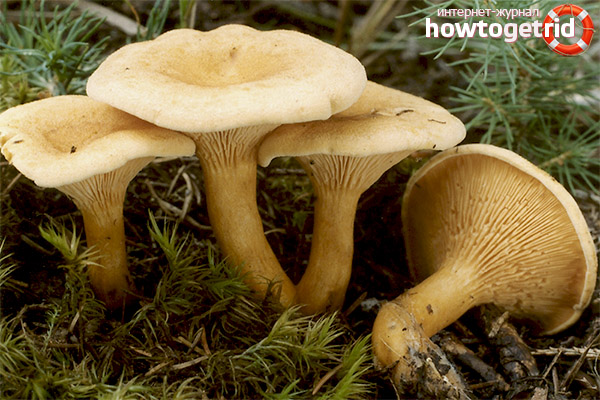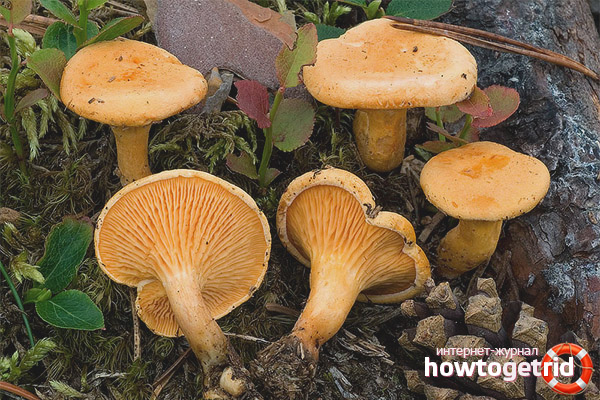The content of the article
The chanterelle is a mushroom widely known among the people, but there is another one that successfully disguises itself as an orange mushroom. In common people, coconut or false fox is most often found in coniferous or mixed forests. Only an experienced mushroom picker can distinguish them from real chanterelles. If you do not have sufficient knowledge and gain false chanterelles, then there is a chance of serious poisoning.
False chanterelle description
- Flat hat from 1.5-6 cm in diameter, velvety to the touch, with slightly lowered edges. The mushroom is saturated orange with a red tint. In larger mushrooms, the color of the hat is yellowish-beige, with a small dent in the center.
- The leg is thin and even, about 1 cm, in height - from 3-5 cm. It is painted the same color as the hat, at the base is brown. The inner part is cottony, fibrous.
- Under the hat, the frequent plates descend to the leg, the same color as the whole mushroom.
- The pulp is light with a pale yellow tint. The smell is subtle, mushroom.
Mushroom spread and seasonality
False chanterelle is widespread in Europe, Asia and Russia. It grows mainly in cool places with plenty of moisture, under decaying stumps and trees, in lowlands under leaves.
Talkers can be found growing individually or in groups. They do not tolerate close proximity and even with group sprouting are at a small distance from each other.
Like most mushrooms, they begin to bear fruit from the end of summer until mid-autumn.
The main differences from similar species
One of the main differences between false chanterelles and real ones is color. In talkers, it has a bright orange or red-orange hue. Edible mushroom has a pale yellow, orange-yellow or white-yellow color, without obvious orange or red tones.
Unlike a velvety coconut hat, a real fox has a smooth surface. Another difference is the edges of the mushrooms. In orange talkers, they are smoothly rounded and even, in edible chanterelles they are wavy, with an irregular shape, in addition, the hat itself is larger.
In a false fungus, the plates are oblong and descend to the stem, in chanterelles they smoothly pass into it. In addition, the leg of the inedible mushroom is much thinner, with a noticeable darkening closer to the base, in the present it is thicker, more even, of the same color and gradually tapers to the bottom.
The pulp of an orange govorushka is friable, uniform, yellowish, with light pressure, the color does not change. In a real fox, the flesh is white, closer to the edges it turns yellow, if you slightly press on it, it acquires a red tint. The smell is light, mushroom.
The nutritional value
Information about the suitability of this fungus is contradictory, some sources claim that after heat treatment coconuts are suitable for consumption. However, most still believe the opposite. As arguments, the facts about the low nutritional value of the mushroom and the high risks of poisoning are given.
In order to protect themselves, orange talkers are soaked for several days, then boiled for about half an hour, and only then used for cooking. It is scientifically proven that, when exposed to temperature, the toxins in their composition are destroyed, but the likelihood of poisoning remains.In addition, after such a number of treatments, the delicate pulp of the mushroom turns into a mushy mass.
Symptoms of Poisoning
The composition of the false chanterelle contains toxic substances that affect the work of the organs of the gastrointestinal tract, liver, and kidneys.
Mushrooms that have gone through all the stages of pre-treatment often cause poisoning. In the case of cooking, without preliminary soaking and cooking, poor health is guaranteed.
Depending on age and weight, the first signs of intoxication may appear after half an hour or within 3 hours after eating a false chanterelle. In rare cases, the symptoms of poisoning showed up one day after eating.
Characteristic signs of poisoning:
- diarrhea;
- weakness;
- nausea and vomiting;
- stomach ache.
In case of poisoning, in no case should self-medicate, it is worth contacting specialists, since there is a threat of botulism.
Beginner mushroom pickers bypass chanterelles, since it is likely to pick up its poisonous counterparts. Coconut does not have a pronounced mushroom taste, which once again makes you wonder whether it is worth risking your health to try it.
Video: false fox (Hygrophoropsis aurantiaca)











Submit